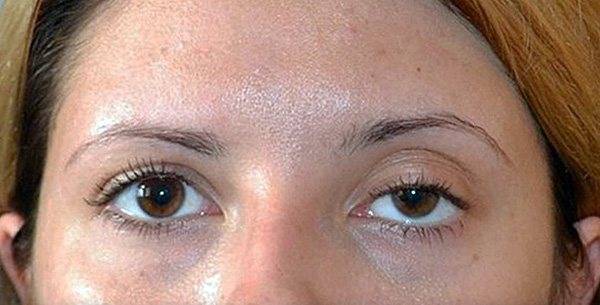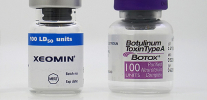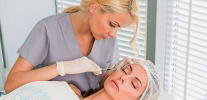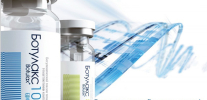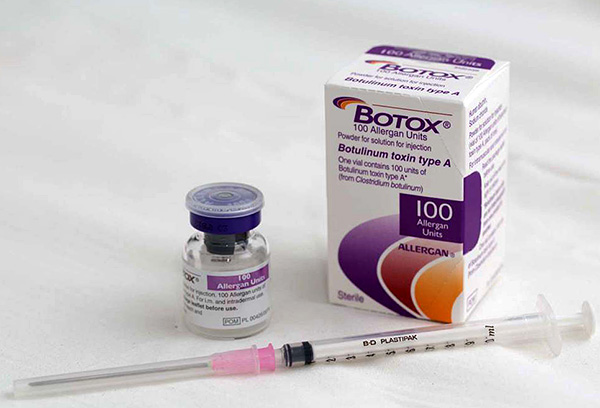
Botox is a drug manufactured by Allergan, which is a topical neuromodulator for use in clinical neurology and aesthetic cosmetology.
Today Botox is best known for the fact that it is actively and successfully used to eliminate facial wrinkles. In this capacity, the drug has gained such widespread popularity that its name has become a household name: most of the counterparts with the easy hands of consumers are also called “Botoxes,” which is incorrect and is considered a mistake in professional cosmetologists.
On a note
In particular, they often say "Botox Allergan." In this case, it is understood that “Botox” is an indication of the type of product (by analogy, for example, with the terms “antibiotic”, “antidepressant”), and Allergan is the name of a specific product.
This is not true. Speaking specifically about Botox, the type of agent here is Botulinum toxin of group A, the name of a particular drug and brand is Botox, and Allergan is just the name of the manufacturer.
The manufacturer of the drug itself, Allergan Inc., operates in more than 100 countries. Initially, the company originated in Ireland, but then, after many mergers and acquisitions, it turned into a conglomerate that produces many medicines and cosmetics around the world. In fact, Botox is produced at several enterprises of the company, its largest volumes are produced in the city of Irvine, California, USA. In Russia, you can buy just the Irish drug, and the American counterpart is produced for the American market.
As a means to combat wrinkles, Botox is very well studied, its properties have been thoroughly studied and methods of application in various clinical cases have been developed. The drug is considered quite safe, although it has some contraindications and can cause certain side effects. With proper use and thorough preliminary diagnostics, the tool really allows you to completely get rid of wrinkles caused by the activity of the facial muscles, as well as correct cosmetic defects in other parts of the body.
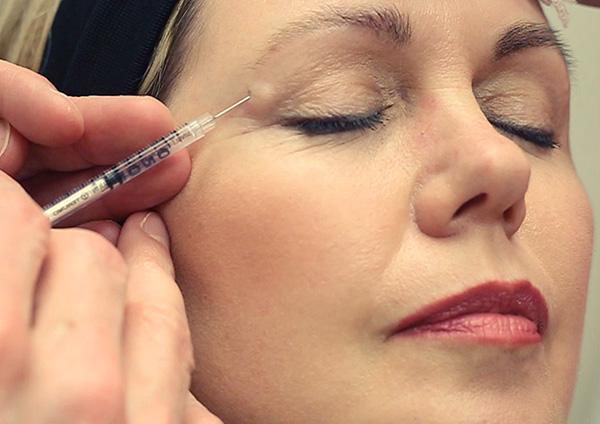
The competent use of the Botox drug allows you to effectively combat facial wrinkles, and the effect of the procedure can last several months.
The key to successful correction of cosmetic problems with Botox is the professional administration of the drug in strictly calibrated doses exactly to the target muscles (in combination with a full understanding by the doctor of the principle of action of botulinum toxin and the causes of certain wrinkles in the patient).
How does all this work in practice? Let's figure it out ...
The composition of the drug and its mechanism of action
Allergan Company produces several types of Botox preparations intended for different purposes. Specifically in cosmetology, Botox Cosmetic is used to combat wrinkles.
Its active ingredient is onotulotoxin A (onabotulinimtoxinA), which is a complex of group A botulinum toxin and several proteins associated with it. When introduced into muscle fiber, this substance concentrates on the periphery of muscle cells and penetrates neurons innervating the cell. Here, botulinum toxin inactivates the proteins responsible for the rupture of synaptic vesicles with acetylcholine. Without the activity of these proteins, acetylcholine, the main neurotransmitter, does not stand out from the neuron and does not stimulate muscle contraction even when a nerve cell receives a “command” impulse.
Simply put, if Botox is injected into a specific muscle, then this muscle loses its tone and relaxes, and then for a certain period of time it does not contract at all - not under the influence of reflex impulses,nor even with conscious attempts by a person to strain it.
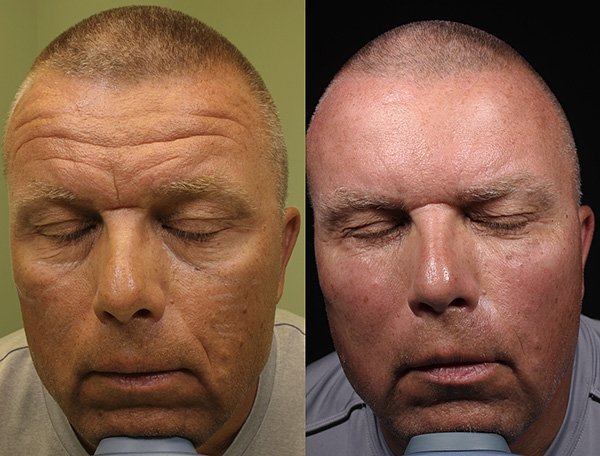
The result of Botox injections in men is deep wrinkles on the forehead almost completely smoothed out.
The main result of this action is the disappearance of wrinkles arising due to the constant voluntary or involuntary contraction of those facial muscles of the face into which the drug is injected. Muscles relax, stop tightening the skin, as a result of which it is smoothed.
The obvious and most innocuous side effect of using Botox is the inability to contract "broken" muscles. This affects the facial expressions: various bright emotions in a person can manifest themselves somewhat unnaturally, since the usual changes on the face with such emotions do not occur.
On a note
For example, after Botox is introduced into the muscle of the proud (Musculus procerus), the expression of emotion is lost between the eyebrows with aggression or discontent - a person simply can’t lower his eyebrows.
Similarly, with a smile, the muscles between the nose and lips (the drug is introduced to eliminate nasolabial folds), and also on the sides of the eyes, may not be involved.
Nevertheless, since all the muscles are not completely treated with Botox injections, the ability to mimic express emotions in humans is preserved. And the more professionally the procedures and preparation for them are carried out, the less noticeable will be the undesirable changes in the facial expressions with the obvious smoothing of wrinkles.
On average, a clear effect from a particular procedure is observed 3-4 days after injection. In some cases, it can be faster and appear on the next day, and sometimes, on the contrary, the desired result is obtained only after 10-14 days.
Feedback:
“The doctor dissuaded me for a long time from Botox, said that my one wrinkle between the eyebrows is generally invisible and it is better to conduct biorevitalization. But I, frankly, was already tired with these endless masks, scrubs, and insisted on Botox. And did not regret it. The whole procedure cost 3200 rubles, in time - 2-3 minutes, well, plus 20 minutes preparation in front of her: grimacing, the doctor looks at the wrinkles, the skin, decides where to prick. Then you sign the consent, they inject you. After 6 days, my wrinkle disappeared. Totally! As if before this 5 years she was not at all. And no inconvenience, no discomfort, the head does not hurt. Either on the official website, or somewhere else I read about various horrors such as jumping eyebrows, drooping eyelids. I didn’t have anything like that. Now it's already 6 months, Botox is slowly letting go. If I’m angry, a wrinkle appears, but normally it is not there yet. So soon it will be necessary to repeat, but it's worth it ... "
Katya, St. Petersburg
The action of Botox is limited in time by an average of 90-110 days (3-4 months). Studies show that during this period, almost all deactivated nerve endings are replaced by new ones as a result of the sprouting process. At the same time, new processes begin to grow from the nerve cell, connecting to the muscle fiber. This process starts immediately after botulinum toxin enters the cell (that is, immediately after the onset of Botox), but it is not fast, and only 3–4 months later can suppress the effect of botulinum toxin.
On a note
Botox from the Allergan company, produced for medical purposes, acts in a similar way, but it is injected into the muscles in various syndromes accompanied by muscle spasms - blepharospasm, strabismus, spastic torticollis, and hemifacial spasm. Here, Botox also provides muscle relaxation leading to spasm. Also, the drug is used in urology to reduce the activity of the detrusor of the bladder, to treat skin hyperhidrosis (increased perspiration) and to eliminate spasms of individual muscles in children with cerebral palsy.
There is practically no difference in efficacy and safety between Botox and other botulinum toxin preparations.The fundamental difference from its analogues is that its active complex is the heaviest - the mass of onbotulotoxin is approximately 900 kDa, while, for example, the abobotulotoxin molecule in Dysport weighs 500-800 kDa, and the molecule of pure botulinum toxin in Xeomin is only 150 kDa.

There are many botulinum toxin preparations on the market today that have different names. The most commonly used in cosmetology are Botox, Dysport and Xeomin.
It is believed that such a large molecular weight and the presence of auxiliary proteins in Botox can affect its distribution in the tissues after injection and the body produces an immune response to it. It is believed that Xeomin diffuses into muscles faster and spreads over a larger area than Botox, which is why Botox distribution is more controlled and less likely to capture and deactivate muscles that were not planned to be processed. However, it is on Botox that the body should, in theory, produce more antibodies, since it contains more specific proteins. This would lead primarily to a shorter duration of Botox, as well as to a higher frequency of allergies to it than to analogues.
According to the results of studies, it was not possible to detect a statistically significant difference in the frequency of side effects and the speed of propagation in tissues between Botox and its analogues. Today, differences in dosages of funds and, accordingly, the order of their dilution, as well as in price, remain practically significant.
Indications for use of the drug Botox
Indications for the use of Botox differ for the field of cosmetology and therapy of various diseases.
In cosmetology, the tool is used for:
- The appearance of permanent wrinkles due to the frequent involuntary or spastic contraction of the muscles of the face, neck, head. Most often, Botox is used to eliminate wrinkles on the nose, forehead and eyebrows, "crow's feet" near the eyes, as well as "rabbit folds" on the nose;
- Healing and healing of deep wounds that leave scars;
- Various cosmetic defects of large skeletal muscles - bulging muscle fibers, too bumpy or massive-looking muscles.
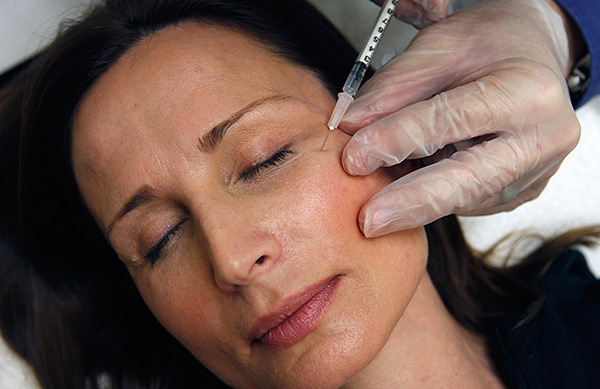
Most often, Botox injections are used in cosmetology specifically to combat wrinkles - on the forehead, in the eyes, nasolabial folds, on the neck and in the decollete.
Wrinkles caused by aging, drying out of the skin, loss of elasticity due to various pathologies are not an indication for the use of Botox. In these cases, various fillers are used (in particular, hyaluronic acid), which restore the normal condition of the skin and subcutaneous tissue. Only a doctor who understands anatomy and understands all the nuances of the interaction of the muscles of agonists and antagonists with other facial tissues can find out why certain wrinkles appeared.
In therapeutic practice, indications for the use of Botox from Allergan are:
- Tonic blepharospasm - closure of the eyelid due to the constant tension of the pretarsal part of the ridge muscle of the eye;
- Various spasms of the muscles of the face (hemifacial spasm);
- Cervical dystonia - cramps of the shoulders and neck, leading to a change in posture, constantly raised shoulders, tilting the head to the side (crank);
- Chronic migraine
- Urinary incontinence in adults caused by neurogenic hyperactivity of the bladder detrusor;
- Horse foot syndrome in children with cerebral palsy;
- Spasm of the wrist and arm in patients with a stroke.
In all these cases, botulinum therapy can be attributed to symptomatic treatment, since it affects only the consequence of the pathology, but not its cause.
Contraindications
Contraindications to the use of Botox is a fairly debated area, since many of them are established by various regulatory organizations in different countries, and often they are indicated on the principle of excessive insurance (“it is better to overdo than not to overdo”), and the relevance of many of them is refuted by the practice of cosmetologists and special studies.

There are not so many contraindications to the use of Botox, and in most cases an average healthy person may well use this tool.
Nevertheless, today the following contraindications to the use of Botox can be distinguished:
- Pregnancy;
- Children's age up to 2 years (earlier Botox was generally forbidden to use in pediatric practice, but with an increase in its importance in the treatment of cerebral palsy, the age limit was reduced);
- Skin infections at the sites of the alleged administration of the drug;
- Allergy to egg white (Botox contains albumin);
- Specifically, to eliminate facial wrinkles - a history of dysphagia and aspiration.
Also, the drug is not recommended to be used (or it is used in smaller quantities) for patients taking aminoglycosides, macrolide antibiotics and some other drugs in parallel - they can enhance Botox's actions, up to the development of undesirable effects.
Instructions for use: preparation for the procedure and procedure for injections
As a rule, Botox injections can be carried out at the first visit to a cosmetologist. First, it is necessary to diagnose the causes of certain wrinkles, check the interaction of antagonist muscles, develop a scheme for administering the drug and plan its consumption by the doctor.
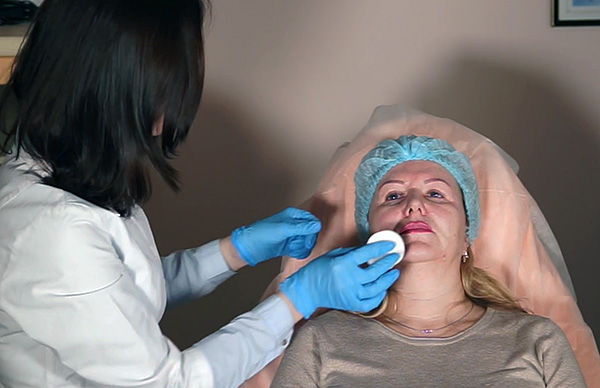
Before injecting the drug, the cosmetologist must present the reasons for the appearance of certain wrinkles in the patient and have a good understanding of which points botulinum toxin needs to be administered to and at what depth.
On a note
In some cases, the patient and the doctor may have disagreements. For example, the patient wants the number of injections and the amount of the injected drug to be minimal, and injections should be carried out only in those muscles that cause wrinkles. But a specialist who is well versed in facial anatomy understands that inactivation of only these muscles can lead to even more severe cosmetic defects due to antagonist activity - this is how “Mephistopheles eyebrows”, some ptosis variants, and “dull face” appear. To avoid such situations, botulinum therapy should be addressed to a highly qualified specialist, and then fully rely on his professionalism.
After the initial consultation, the doctor informs the patient about possible side effects and gives him informed consent to use Botox for signature.
Immediately during the injection, the patient is seated in a chair in which it is convenient to adjust its tilt and height of the head.
The doctor restores Botox solution from the powder, taking into account the specifics of a particular procedure. Each Botox bottle contains 100 IU of the active substance, which is normally diluted in the bottle itself with pure saline (sodium chloride solution) with a volume of 2.5 ml to obtain a final drug concentration of 4 PIECES per 0.1 cm3. However, in some cases, to eliminate wrinkles or to treat some pathologies, dilutions can be different, and the value in each case is determined only by the doctor.
The photo below shows a bottle of Botox (Allergan) at 100 PIECES:
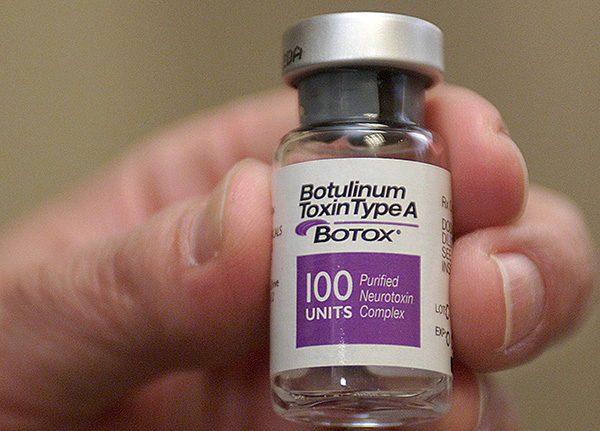
Botox (Allergan), 100 units
On a note
The form, on one side of which there is informed consent for the use of Botox, on the other usually has a form describing the use of the drug, with a map of points for injection, as well as a description of the patient's condition before the procedure and a listing of standard dilutions - 1.25 U / 0.1 ml2.5 PIECES / 0.1 ml, 4 PIECES / 0.1 ml, 5 PIECES / 0.1 ml, 10 PIECES / 0.1 ml. The doctor emphasizes here which will apply, or enter a unique meaning. It also indicates how many units of the drug will be introduced at each point.
Then:
- The doctor draws a solution of the drug into the syringe;
- The face is treated with frozen gel or a special anesthetic for easy local anesthesia;
- The doctor begins to inject the drug into the muscles. The place of each introduction of the product is slightly pressed down with a finger. In some muscles, the drug can be administered several times during the procedure. The amount of the drug is determined by the strength of the muscle contraction, the dilution of the drug, the severity of wrinkles and some other factors. On average, for example, 5 units of Botox are injected into a muscle that wrinkles an eyebrow per injection, and 17-20 units are introduced into a muscle that lowers the central part of an eyebrow.
At the end of the procedure, the skin is wiped with a damp cotton swab, the doctor monitors the patient's condition. If there are no signs of an allergic reaction, the procedure ends. Its duration is usually 10-40 minutes.
On the skin after the procedure, subtle red spots remain at the injection sites, which disappear the very next day.
For 3-4 days after botulinum toxin injections, it is extremely important to carefully monitor your condition, and if you have signs of generalized side effects, consult a doctor.
A few words about possible side effects and how to respond to them
Side effects from the use of Botox can be divided into local and systemic.
Local include various disorders of facial expressions and muscle conditions of the treated areas of the face and body, which affect the appearance and some functions of the patient's body. Among them:
- Ptosis (blepharoptosis), sometimes with complete closure of the eye;

An example of a patient’s eyelid dropping after Botox correction of wrinkles. Fortunately, this is reversible, and there are methods that accelerate the restoration of a normal state.
- Distortion of facial features, violation of symmetry, including during various facial movements - a smile, sardonic raising of eyebrows;
- Raising the corners of the eyebrows;
- Paresis or paralysis of the treated muscles (more often due to medical errors, but can also occur if the procedure is carried out correctly);
- Reducing the strength and frequency of blinking of the eye, sometimes the inability to close the eye, which subsequently leads to drying of the cornea and the need to instill moisturizing drops into the eye;
- Dysphagia (inability to swallow);
- Violation of the jaw muscles and related problems with the pronunciation of sounds and eating;
- Swelling on the face.
Today, there are botulinum toxin antagonists that can correct side effects. However, in most cases, a good understanding by the doctor of the anatomy of the face and the absence of errors with the introduction of Botox are a reliable prevention of such phenomena.
Systemic side effects of Botox include:
- Headache after injection;
- Respiratory and flu-like syndromes;
- Nausea;
- Allergic reactions.
They rarely occur, but they have a place to be, therefore both the patient and the doctor must be prepared for their development. Of these, allergies and headaches develop most quickly - usually during the injection process. Moreover, the allergy is developing rapidly and requires the presence of adrenaline in the doctor to prevent the dangerous effects of anaphylactic shock.
All other systemic effects usually disappear 3-4 days after the procedure.
Feedback
“I decided on Botox when I was 31 years old. I have wrinkles almost from my college years, too emotional face and mobile facial expressions. On the nose and forehead they were the most, even at one time wore bangs to cover them. As a result, I decided on Botox, because I have a girlfriend, a cosmetologist, who specializes in this procedure. Since then, 7 times have been stabbed every 12 weeks. The effect is amazing, there are no wrinkles at all! And even the very deep ones are completely gone.I get 19 units for each procedure. This is very little. There are no side effects, nothing hurts, I normally raise my eyebrows, there is no sensation of a waxy face. I think that if a specialist does, he will inject as much as necessary and where necessary and there will be no side effects. ”
Inga, Moscow
About the purchase of Botox and its fakes
Botox from the Allergan company is now available for sale, and you can buy it in offline and online pharmacies or cosmetics stores. The price of one bottle per 100 units is approximately 12,000 rubles.
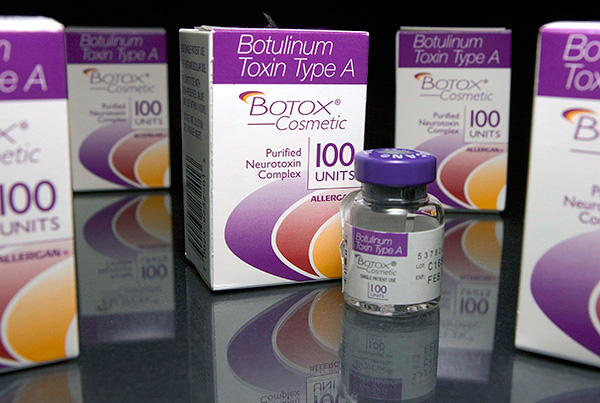
In most cases, it is not advisable to independently purchase Botox - in the clinic they may simply refuse to use it (and they will be right).
At the same time, independent purchase of funds cannot be called expedient. In any case, the doctor will have to do the injections in the clinic, and the clinics themselves purchase the original Botox certified in large quantities at wholesale prices.
On a note
Due to the fact that one patient is administered not a whole bottle, but a small amount of the drug, its cost for one procedure is low. For example, the removal of one glabellar wrinkle costs about 3,500-5,000 rubles in Moscow, and the removal of "crow's feet" costs 5,000-7,000 rubles.
Allergan's manufacturing facilities are located in several countries around the world. Botox, produced in Ireland, enters the European market and Russia; a drug manufactured in California is sold in America. The company also has its own factories in Turkey, however, it is not known whether Botox is produced there, including for the European market (the company produces other pharmaceutical products in addition to Botox). It is dangerous to try to buy cheap Botox, as you may encounter fakes. Moreover, patients with "their" drug injections in serious clinics do not.
It is strictly forbidden to attempt injections yourself in order to save finances. This can lead to damage to nerves and blood vessels, and theoretically, even toxin entering the bloodstream and the development of symptoms of botulism. Therefore, all procedures with the drug should be carried out only by a highly qualified specialist who knows the face anatomy well, the instructions for using Botox, and also understands the specifics of administering the drug in each particular case - the depth of the needle, dose, area. Without this knowledge, injections can be dangerous and useless.
What to prefer: American Botox or French Dysport?
Useful video: TOP 5 possible complications from Botox injections

